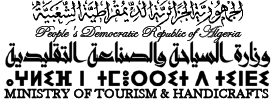- From the north: Wilaya of Mila, Oum El Bouaghi, Wilaya of Setif.
- From the east: Wilaya of Khenchela.
- From the west: Wilaya of M’sila.
- From the south: Wilaya of Biskra.
Sitting on an area of 12,038.76 km2; the Wilaya of Batna is one of the oldest Wilayas in independent Algeria.
As an administrative district of modern times, its creation took place during the French occupation; shortly after the occupation of Constantine, when the Duke of Aumale, appointed governor in 1843, decided to restore order to the Ziban.
Indeed, a column under the orders of Colonel Buttafoco is on the way at the end of January 1844. She bivouacked around Ain M’lila, then in Ain Yagout in February; and in March this column arrived at the eastern entrance to the present city of Batna. The Duke of Aumale, bringing together his staff then decided to create a military camp in this place.
Immediately, the camp was assaulted by the Ouled Soltane, that in April, it will be moved about 2 km to the South East, very close to the ruins of Ras El Aioun, where the Negro Village will be built.
In this new place that was called: Ras El Aioun – Batna; A few small houses were built around the camp and the city began to be born.
By a Decree of 1848, the fledgling city was given the name of New Lambese and in June 1949, another Decree called it BATNA. The western sector of the city, made up of gardens and meadows, was then baptized: the greenery.
Shortly after, the Infrastructures that were built were: – The two schools (Jules-Ferry and Gambetta) in 1851, – the justice of the peace in 1853. – The Church in 1858 (Consecrated in 1863).
In February 1860, another Decree made Batna a full-service Commune. At that time, it had 5,990 inhabitants: 1,947 French, 647 Jews (before the Crémieux decree of 1870), 273 naturalized foreigners, 384 foreigners and 2,739 natives who were called the “natives”. It had a municipal council elected in 1866.
In 1871, during the uprising of ElMokrani the city was besieged and fear led to disproportionate repression. Constantine’s division moved to Batna in December, and a perimeter wall was built with four gates and redoubts which are: the fort and the Bordj Bou Diaf.
From 1875, we started: – Construction of the railway line to Biskra -The confiscation of land and its distribution to new settlers emigrated from Alsace Lorraine.
In 1885, Batna was established as a Sub-prefecture, the seat of the military subdivision of the Department of Constantine.
After 1891, the centers of colonization began to be created: – Merouana (Corneille) in 1905
In 1916, during the uprising of the Ouled Soltane around Mac Mahon. Barika, Medina, Aïn Touta are assaulted, the sub-prefect of Batna is killed, as well as the administrator of Mac Mahon.
The repression lasted until April 1917, using troops from Tunisia, artillery and a squadron of planes. Since then, Batna will play the role of administrative and commercial center, favored by a new contribution of Spanish and Italian colonists; that by 1949 the city’s population will exceed 25,000. In those times revolts followed one another, until the day when the song of the revolution was sung on a memorable day of November 1, 1954.
The colonial army, reinforced by the African hunters, the Senegalese legion, paratroopers, artillery, armor and air force, tried in vain to control the maquis which was gradually expanding.
In the city, a state of emergency sets in and the repression is more and more brutal. Neighborhoods were squared off and no-go zones were created.
The Camp, the Fortin, the Red Farm (F. Lahmar, near Fesdis), will serve as places of torture. The Lucas farm will regroup the suspects before they are sent to Constantine.
In 1956 Batna became the capital of the Aurès department until independence. It had as sub-prefectures: Biskra, Tebessa, Khenchela, Corneille and Arris.
The wilaya of Batna is divided into a group of municipalities and districts, as follows:
Dayra |
Municipal |
|---|---|
| Aïn Djasser | Aïn Djasser – El Hassi |
| Aïn Touta | Aïn Touta – Ben Foudhala El Hakania – Maafa – Ouled Aouf |
| Arris | Arris – Tighanimine |
| Barika | Barika – M’doukel – Bitam |
| Batna | Batna – Fesdis – Oued Chaaba |
| Bouzina | Bouzina – Larbaâ |
| Chemora | Chemora – Boulhilat |
| Djezzar | Djezzar – Ouled Ammar – Abdelkader Azil |
| El Madher | El Madher – Aïn Yagout – Boumia – Djerma |
| Ichmoul | Ichmoul – Foum Toub – Inoughissen |
| Menaa | Menaa – Tigherghar |
| Merouana | Merouana – Oued El Ma – Ksar Bellezma – Hidoussa |
| N’Gaous | N’Gaous – Boumagueur – Sefiane |
| Ouled Si Slimane | Ouled Si Slimane – Taxlent – Lemsane |
| Ras El Aioun | Ras Ei Aioun – Gosbat – Guigba – Rahbat – Talkhamet – Ouled Sellam |
| Seggana | Seggana – Tilatou |
| Seriana | Seriana – Lazrou – Zanat El Beida |
| Tazoult | Tazoult – Ouyoun El Assafir |
| Teniet El Abed | Teniet El Abed – Oued Taga – Chir |
| Timgad | Timgad – Ouled Fadel |
| T’kout | T’Kout – Kimmel – Ghassira |


